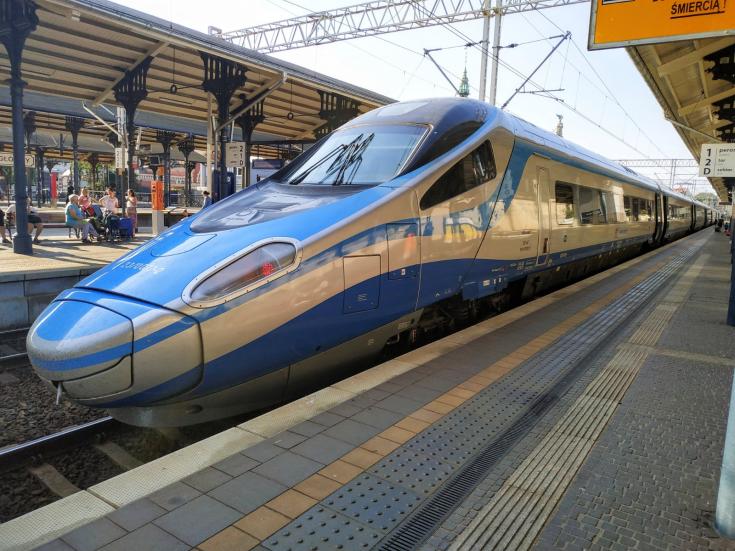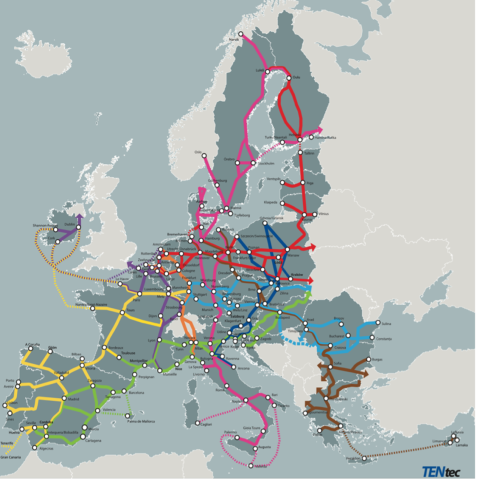Connecting Europe: A regional perspective on the Trans-European Transport Network

The Trans-European Transport Network (TEN-T) is a significant initiative of the European Union, aiming to support the single market by facilitating the movement of people, goods, and services across Europe, and promoting economic growth, competitiveness, and integration.
Under TEN-T, Europe’s cities and regions will be empowered to implement new infrastructure projects but also obliged to meet new requirements for sustainable transport planning. They therefore need to prepare to embrace the significant opportunities of this major infrastructure project.

Source: European Commission. Explore further with the European Commission's interactive map.
The revised TEN-T Regulation, currently going through the legislative process strengthens the existing TEN-T plans with new connections between ports, airports, border crossings, rail-road terminals, and urban nodes – urban areas where the infrastructure of TEN-T is connected with other parts of that infrastructure and with the infrastructure for regional and local traffic.
Under the proposal, the number of nodes will expand from 88 to more than 430, meaning that authorities across the continent must consider their local plans in a new European framework, and meet new obligations.
Urban nodes will need to ensure the availability of alternative fuel recharging points in logistics platforms and for public transport and adopt a Sustainable Urban Mobility Plan (SUMP) by the end of 2025.
By the end of 2030, urban nodes must provide:
- Interconnection between transport modes
- Give passengers access to information
- Allow payment for their journeys through digital services
- Develop multimodal passenger hubs to facilitate first and last-mile connections
Nodes will also have to develop at least one multimodal freight terminal by the end of 2040.
Additional priorities include connecting the TEN-T and local transport networks, mitigating the exposure of urban areas to the effects of transiting rail and road, promoting low-noise, zero-emission transport, increasing active and public transport, and enabling digital exchange of transport and traffic information between traffic management centres.
Implementing these changes will require collaboration between regional, national and European authorities to identify priority projects, secure funding and ensure alignment with regional development goals. They will also be required to engage with various stakeholders and collaborate with regional partners including the public and businesses, as well as managing trade-offs including environmental impacts and land use conflicts.
Support for implementing TEN-T
Understanding and implementing the necessary changes will be challenging for many cities, which will have to learn from existing nodes and cities that have already implemented SUMPs or worked on multi-modal hubs.
Cities and Regions must already begin to build their capacity, including developing the necessary skills and competencies for managing stakeholders and multi-level governance, collaborative and citizen engagement processes, and the production, implementation and updating of SUMPs.
Under the regulation, member states will be required to establish a national SUMP support programme and improve coordination between regions, cities, and towns. They should also reinforce monitoring and evaluation of implementation through legislative measures, guidance, capacity building, and financial support.
Until then, cities can prepare by seeking support through several EU funds and programmes, including:
- the Connecting Europe Facility (CEF)
- the European Structural and Investment Funds (ESIFs)
which are the main sources for investment into the physical and digital infrastructure of TEN-T. The ESIFs provide additional financial resources to support transport infrastructure investments in EU member states and regions, and complement the CEF for TEN-T projects, particularly in less developed or economically disadvantaged areas.
In terms of capacity building, the Horizon Europe Mission on Climate-neutral and Smart Cities supports selected cities as experimentation and innovation hubs for others to follow by 2050. The European Institute of Innovation and Technology (EIT) Urban Mobility initiative also enables the deployment of pilot projects, demonstrations, and knowledge-sharing activities that help cities prepare. Interreg Europe can also play a role, enabling capacity building between advanced and learning regions under its Connected Europe priority.
While the full picture and timeline will only become clear with the completion of the legislative process, the direction of travel is clear, and regional authorities already need to consider their financial and skill requirements to make it a success.
The tools are out there for front-runner regions, looking to get a head start.
By Simon Hunkin, Thematic Expert for a Greener Europe and more Connected Europe.
Simon has eight years' experience in the low-carbon economy sector, working in projects and studies to support uptake of innovative low-carbon technologies and policy instruments. He is specialised in European energy and environment policy, as well as regional policy and funding and co-operation initiatives.

